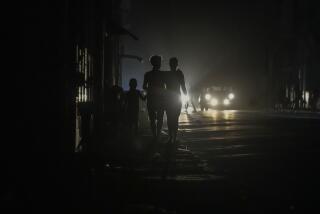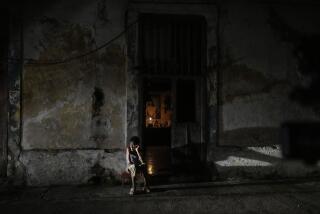âIt Never Be the Old Bluefieldsâ : Nicaraguaâs Different City Shattered by âBig Breezeâ
BLUEFIELDS, Nicaragua â When Bluefields celebrated its 85th anniversary as a city last week, it was a funky fishing port with a reggae beat and an Afro-Caribbean visage--a crazy quilt of brightly painted wooden houses and magnificent churches sprawled along a bay. Long in decay, it was still proud to be different from the rest of Nicaragua.
The anniversary festivities, and much that was Bluefields itself, came to a traumatic end last Saturday at 2:47 a.m. That was the time frozen on the clock tower of the Roman Catholic cathedral when Hurricane Joan swept ashore with what residents now recall in awe as âthe Big Breeze.â
Today, the city looks as if it has been razed by a megaton bomb set off in the bay. The stormâs 135-m.p.h. blast, which was likened to the roar of a jet taking off and lasted 11 hours, toppled or smashed all but about 100 of Bluefieldâs 6,000 homes, uprooted trees and sent virtually every roof flying. The scene is dizzying: What little still stands is tilted at obtuse angles.
âThe breeze come plenty hard, man,â said Reynaldo Sambola, a 28-year-old fisherman with the lilting English of the Black Creole dialect. âMy house blown down to nothing. Whole coast is wrecked, man. It take three, four years to build back up, in my way of thinking. But it never be the old Bluefields.â
The wreckage here is perhaps the most poignant legacy of a season of rambling killer hurricanes. Scores of settlements from Barbados to the Texas Gulf Coast were battered, as they are each year in late summer and early autumn, by tropical storms. Although Joan took just 13 lives here, the locals, known as Bluefilenos, say it eroded two pillars of a culture already declining under Sandinista rule.
One pillar is its architecture. Gone is the best-known landmark, the century-old Moravian church with its white New England wood frame and maroon trim. Of 120 Caribbean-style wooden buildings marked for restoration before the hurricane, 117 were destroyed, including the Croddell Hotel and the Tropical Club. Although traditionalists resist the idea, city officials say Bluefields will be rebuilt mostly of prefabricated concrete.
In a more subtle shift, the hurricane is expected to drive blacks from Bluefields in larger numbers than the mestizo, or mixed Indian-European, people who have slowly outnumbered them here in the past decade. Black people have stronger family ties to the United States and Canada, and many talk of emigrating to escape the desolation.
âBluefields will develop more and more along the lines of a mestizo town than a Creole-African town,â said Edmundo Gordon, a University of Texas anthropologist who studies Nicaraguan coastal people. âThis disaster will make it more like any other Nicaraguan town.â
Early British Settlers
Bluefields, named for a Dutch pirate called Blauveldt, was first settled by British lumberjacks and privateers who attacked the Spanish fleet 400 years ago. When the British left in 1894, descendants of their African slaves came under the rule of Nicaraguaâs Hispanic majority.
For most of this century, Managua ignored Bluefields, which still has no road to the rest of the country. Ships brought goods from all over the world, while U.S. fishing and lumber companies dominated the local economy.
Things changed with the Sandinista Revolution in 1979. Insensitive to local traditions, the new rulers quickly antagonized the anti-Communist coastal people with commercial restrictions and plans to bring in Cuban teachers. After some native boys joined the U.S.-backed Contras, Bluefilenos were burdened with military conscription, a large army presence and an influx of war refugees that swelled the population from 25,000 to 38,000.
Tensions have eased since Managua put Sandinistas who are Creole natives in local leadership posts. A 1987 autonomy law promises local elections and greater self-determination for coastal people. But the voting, scheduled for next March, has been put off indefinitely by the disaster.
Given the lingering climate of mistrust in Bluefields, it was not surprising that few residents took seriously the hurricane warnings issued last week from Managua, even when President Daniel Ortega arrived in person to dramatize them. Besides, they reasoned, no hurricane had ever struck this far south in this century. Fifteen of the 34 evacuation boats left town empty.
âFirst of all, we donât know what a hurricane is, really, and second, the government is always telling us things that are foolishness,â said fisherman Deny Hill.
Many Bluefilenos now credit the Sandinistasâ talent for meticulous block-by-block organization for preventing a greater tragedy. A committee in each neighborhood identified those who had refused to move into sturdy shelters by Friday evening and sent rescue gangs to pull them in by rope through the howling midnight storm--a heroic effort that saved scores of lives.
Today, anyone can sleep and have a free lunch in one of the cityâs 23 storm shelters--lobster is served occasionally--or line up for free rations of rice, beans, flour, salt and sugar at government stores. Medical teams, augmented by Cuban volunteers, have fanned through the city instructing people to boil drinking water and dig latrines.
âThere isnât one person in Bluefields who doesnât know where to go to get taken care of,â said community leader Johnny Hodgson.
But Bluefields is overwhelmed by the immensity of its destruction. There is no electricity, and officials say it cannot be fully restored until next year. The state-owned fishing industry, which employs most of the town, is shut because its three processing plants were destroyed. Three refrigerator ships were saved, but they are being used to preserve blood plasma and medicine for the hospital until the power is back on. Commerce is paralyzed, and the school year is lost.
Given their affinity for things American, Bluefilenos say there can be no real recovery without U.S. aid. Meanwhile, a score of Cuban relief flights with everything from mosquito spray to mango paste have landed at the Bluefields airstrip. âWe have to take Communist help because we donât have no one else,â grumbled Derek Evans, 29. âBut if we can get things from the U.S.A., I guarantee you that in one, two years, we have Bluefields set up again.â
In some ways, the town is springing quickly to life. Telegraph service was restored Tuesday, and the first restaurant reopened that night. The radio station expects to be back on the air next week.
To a visitor who closes his eyes, the most striking feature of Bluefields is the incessant hammering. Anyone with a mallet--there seem to be thousands--is scavenging for boards, nails and sheets of corrugated tin roofing and banging their homes back together. The din lasts into the night.
According to informal rules worked out among townspeople, âany scrap material that lands in your yard is yours,â even if it was part of somebody elseâs house. Places like the seaside market, now a mound of rubble, are a no manâs land, but anyoneâs private scrap pile in such areas must be respected.
âThese people are incredibly stoic,â said Gordon, the anthropologist. âThey are used to war and disease and suffering. They get on with what must be done without a lot of unproductive complaining and gnashing of teeth.â
Bluefieldsâ easy-going social order broke down seriously, however, in the predawn hours after the hurricane. With volunteer security brigades off guard, looters struck the state-owned farmersâ store, the hospital warehouse and the rubble of unguarded homes. They stole fertilizer, hospital gowns, medicine, clothing, television sets--âanything they could sell to survive the trauma of this disaster,â said Donald Weil, the hospital director.
Faced with deepening hardship, many young people, especially blacks, are leaving. But some of the townâs Creole leaders see an opportunity in the disaster.
âWe have a chance to organize this city the way a city should be organized,â said Dr. Cirilo Omier, a Temple University graduate who heads the local Red Cross. âWe can put in streets and a water system that reach all the people.â
Hodgson, the community leader, rejected the idea that Creole culture will suffer.
âHey, man, the houses fell down, but we didnât die,â he told a visitor to the wreckage of his home overlooking the bay. Just then, a jeep load of youths rode by in the moonlight, blaring reggae music from a âboom boxâ plugged into the vehicleâs generator.
âWe are not going to lose our music, our language or our food,â Hodgson said. âIn five months, weâll have this place dancing again.â
More to Read
Sign up for The Wild
Weâll help you find the best places to hike, bike and run, as well as the perfect silent spots for meditation and yoga.
You may occasionally receive promotional content from the Los Angeles Times.






